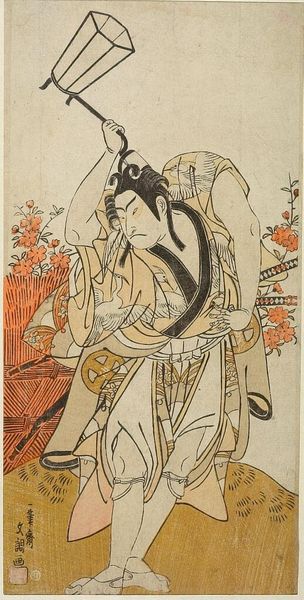
#
ink painting
# print
#
asian-art
#
ukiyo-e
#
figuration
Dimensions: H. 27 1/5 in. (69.1 cm); W. 3 7/8 in. (9.8 cm)
Copyright: Public Domain
Curator: Looking at this fascinating print titled "An Umbrella Jump" by Isoda Koryūsai, made sometime between 1759 and 1779, it is a fantastic example of Japanese Ukiyo-e art now residing at The Met. I am immediately struck by how weightless the figure appears, almost as if floating. Editor: The seeming weightlessness strikes me too, but it's not only a feeling but likely tied to the social commentary implied within this representation. Is it possible that Koryūsai is critiquing the artificiality of the floating world – a space where identities are performed and freedom is merely an illusion? The visual softness could then be seen as reinforcing the fragile status of women within Edo society, hanging precariously in the balance. Curator: I appreciate that socio-political read! I'm thinking more concretely about the production itself – we're talking about a woodblock print here. This was mass-produced, meant for consumption, so that directly impacted the material value. It’s worth investigating how such pieces made art accessible but perhaps also objectified the depicted geishas. Editor: Yes, accessibility is key here, I agree. Ukiyo-e were commercial ventures. But let's think about how, at that time, representations of women shaped ideas about gender roles. What did these prints normalize or subvert regarding social expectations of the era, concerning beauty standards and appropriate behaviors for women? I suspect there’s a radical critique woven into the threads here. Curator: Potentially, and Koryūsai likely would've been working within a very particular workshop system. So his authorship, even with this distinct stylistic sensibility, might actually reflect collaboration across multiple craftspeople handling cutting and printing to realize his design and, consequently, influence what was available to the public. Editor: This forces us to question, also, how his own subject position – his access to portraying these women within the confines of artistic convention – may affect the truth or distortions presented, regarding sexuality, objectification, class – ultimately revealing not only artistic technique but complicated systems of power. Curator: Agreed. That’s why bringing in contemporary intersectional perspectives helps unlock multiple readings and interpretations. Even of an old, seemingly simple, woodblock. Editor: Indeed. It seems what appears carefree might actually contain a charged dialogue. A true call to question social realities, if we are brave enough to delve deeper than a single image lets on.
Comments
No comments
Be the first to comment and join the conversation on the ultimate creative platform.













